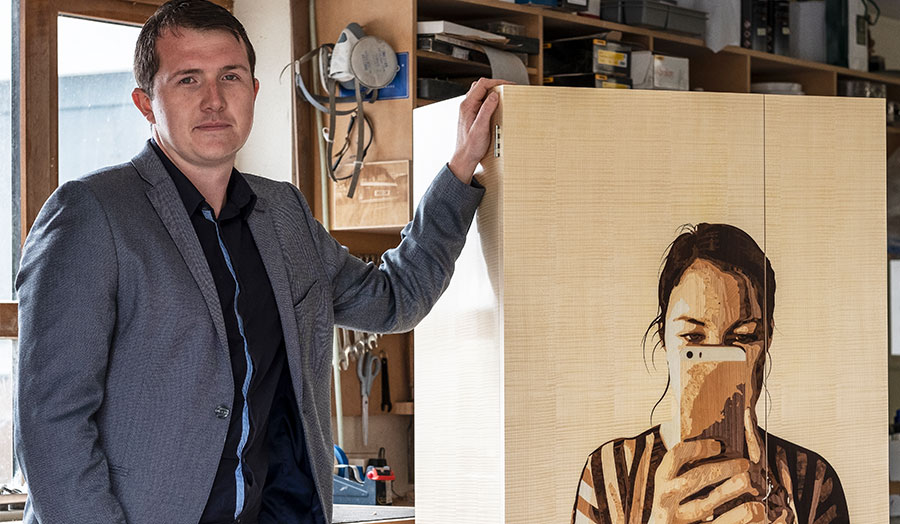Ciarán completed his Furniture Design MA in 2013 and is now a furniture designer/maker who specialises in the art of marquetry and creating luxury furniture for the global furniture industry all from his workshop in rural Ireland. His company The Veneerist Ltd is located in picturesque Donegal and aims to provide new options, designs and products to the Irish and international markets.
Why did you choose to study at London Met?
After finishing my degree in furniture design and manufacture in Ireland, I decided to further my studies in design abroad. London Met had a master’s programme focused specifically on furniture design. The University’s location in central London was an appealing prospect to me. It was a one-year course, which meant I could get the qualification within a year and focus on working, so it ticked all the boxes.
What were the facilities like at London Met?
Facilities were very good. I really liked the fact that multiple disciplines such as jewellery, fine art, woodwork and metal work are all under the one roof. It was really interesting to be surrounded by people from different design disciplines and have the chance to see these other disciplines in action.
What did you like best about your course?
In addition to working with students from different design disciplines, I liked that we also did various trips to different museums and galleries in London, such as the V&A. We also went on a class trip to Italy to explore furniture factories.
Did anything surprise you about your course or London Met?
The size of the University and the amount of different courses and industries that it covers was a surprise.
What do you like about life in London?
There is so much to do and everything in terms of design is on your doorstep.
Tell me about your company The Veneerist and how you came to set this up?
I had a passion to create my own work that would allow me to both design and make. I saw a niche in the Irish market for this type of work and decided it was the best option for me.
Can you explain what marquetry and veneers are and how you moved from furniture to focusing on this aspect of design?
Marquetry involves the cutting and piecing together of thin pieces of wood, known as veneers. In simple terms you could say I’m a glorified jigsaw maker! The veneers are formed into decorative patterns and artworks that can be applied to a wide variety of surfaces from table tops and wall panels to jewellery boxes and detailed flooring inserts. I use both the traditional technique by hand and also laser technology. Marquetry almost disappeared as it was seen as old fashioned, however new laser technology means that you can do a modern take on it.
I was introduced to the technique when I was studying my undergraduate degree in Ireland. It was something that I seemed to incorporate in all my designs and pieces. I saw huge potential and possibilities for this technique and it was something that I wanted to explore. After my master’s I applied for a job with Ace Marquetry in the UK and worked for them for a year and eventually decided to move back to Ireland and set up my own company.
Can you tell us a bit more about your key markets and some interesting clients or projects you have worked on?
Marquetry is a highly skilled and time-consuming craft, which means that it can be an expensive addition to design projects. As a result, the main markets for marquetry are in luxury furniture and high-end interiors for things such as superyachts and corporate gifts or for private clients and hotels.
A lot of my work is for other companies and can end up all over the world. Most projects are confidential so I can’t really discuss clients and details unfortunately.
You are based in the Irish-speaking area of Donegal with a bi-lingual website. Is Irish an important part of your work and identity?
It’s an important part of our culture and heritage and it certainly adds to the narrative of the company. Where I’m based in Donegal is rural and rugged and it’s a part of Ireland that has remained untouched, with natural beauty in abundance. Although the majority of my work ends up in London, New York, Dubai and further afield, it has humble beginnings in a small workshop in rural Ireland, which is something that I’m proud of.
This duality of modern and traditional is reflected in my work too – the contrast of working with a natural product like wood and using the technological advances such as laser and online communications to expand the business.
How did your time at London Met help you in your career?
I learnt a lot from my time at London Met and the master’s definitely helped me in terms of design. It opened me to new ideas, concepts and materials and seeing other disciplines at work helped broaden my interest in other areas of the design world. Having the master’s qualification was also extremely helpful when it came to applying for funding to set up my business. It definitely gave me the competitive advantage.
What are your future plans?
I’m planning on creating more of my own pieces. At present the majority of work is for other companies but my main target will be to create my own brand and identity and find my place in the design world.
Photo credit: Declan O'Doherty, Altan Studio

